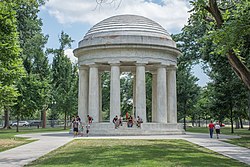
The Lincoln Memorial is a U.S. national memorial that honors the 16th president of the United States, Abraham Lincoln. An example of neoclassicism, it is in the form of a classical temple and is located at the western end of the National Mall in Washington, D.C. Henry Bacon is the memorial's architect and Daniel Chester French designed the large interior statue of a seated Abraham Lincoln (1920), which was carved in marble by the Piccirilli brothers. Jules Guerin painted the interior murals, and the epitaph above the statue was written by Royal Cortissoz. Dedicated on May 30, 1922, it is one of several memorials built to honor an American president. It has been a major tourist attraction since its opening, and over the years, has occasionally been used as a symbolic center focused on race relations and civil rights.

Washington, D.C., formally the District of Columbia and commonly known as Washington or D.C., is the capital city and federal district of the United States. The city is on the Potomac River, across from Virginia, and shares land borders with Maryland to its north and east. It was named for George Washington, the first president of the United States. The district is named for Columbia, the female personification of the nation.

The National Mall is a landscaped park near the downtown area of Washington, D.C., the capital city of the United States. It contains and borders a number of museums of the Smithsonian Institution, art galleries, cultural institutions, and various memorials, sculptures, and statues. It is administered by the National Park Service (NPS) of the United States Department of the Interior as part of the National Mall and Memorial Parks unit of the National Park System. The park receives approximately 24 million visitors each year. Designed by Pierre L'Enfant, the "Grand Avenue" or Mall was to be a democratic and egalitarian space—the complete opposite of the gardens of Versailles where only royalty and nobility accessed similar spaces in size and scope.

West Potomac Park is a U.S. national park in Washington, D.C., adjacent to the National Mall. It includes the parkland that extends south of the Lincoln Memorial Reflecting Pool, from the Lincoln Memorial to the grounds of the Washington Monument. The park is the site of several national landmarks including the Korean War Veterans Memorial, Jefferson Memorial, Franklin Delano Roosevelt Memorial, George Mason Memorial, and the Martin Luther King Jr. Memorial.
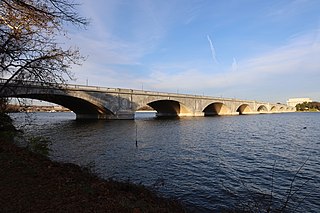
The Arlington Memorial Bridge, often shortened to Memorial Bridge, is a Neoclassical masonry, steel, and stone arch bridge with a central bascule that crosses the Potomac River in Washington, D.C., the capital of the United States. First proposed in 1886, the bridge went unbuilt for decades thanks to political quarrels over whether the bridge should be a memorial, and to whom or what. Traffic problems associated with the dedication of the Tomb of the Unknown Soldier in November 1921 and the desire to build a bridge in time for the bicentennial of the birth of George Washington led to its construction in 1932.

The George Mason Memorial is a memorial to Founding Father George Mason, the author of the Virginia Declaration of Rights that inspired the United States Bill of Rights. The Memorial is located in West Potomac Park within Washington, D.C. at 24 E Basin Drive SW, which is a part of the Tidal Basin. Authorized in 1990, with a groundbreaking in 2000 and dedication in 2002, the memorial includes a sculpture of Mason, a pool, trellis, circular hedges, and numerous inscriptions. It was the first memorial in the Tidal Basin area to be dedicated to someone who was not a former President of the United States.
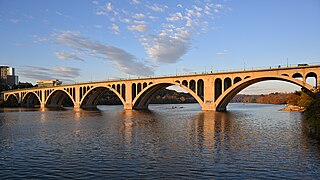
The Francis Scott Key Bridge, more commonly known as the Key Bridge, is a six-lane reinforced concrete arch bridge carrying U.S. Route 29 (US 29) across the Potomac River between the Rosslyn neighborhood of Arlington County, Virginia, and the Georgetown neighborhood of Washington, D.C. Completed in 1923, it is Washington's oldest surviving road bridge across the Potomac River.

Hains Point is located at the southern tip of East Potomac Park between the main branch of the Potomac River and the Washington Channel in southwest Washington, D.C. The land on which the park is located is sometimes described as a peninsula but is actually an island: the Washington Channel connects with the Tidal Basin north of the park and the Jefferson Memorial. The island is artificial: it was built up from Potomac dredging material from 1880 to 1892.
The National Capital Parks was a unit of the National Park System of the United States, now divided into multiple administrative units. It encompasses a variety of federally owned properties in and around the District of Columbia including memorials, monuments, parks, interiors of traffic circles and squares, triangles formed by irregular intersections, and other open spaces.
National Mall and Memorial Parks is an administrative unit of the National Park Service (NPS) encompassing many national memorials and other areas in Washington, D.C. Federally owned and administered parks in the capital area date back to 1790, some of the oldest in the United States. In 1933, they were transferred to the control of the National Park Service. These parks were known as the National Capital Parks from their inception until 1965. The NPS now operates multiple park groupings in the D.C. area, including National Capital Parks-East, Rock Creek Park, President's Park, and George Washington Memorial Parkway. National Mall and Memorial Parks also provides technical assistance for the United States Navy Memorial.

East Potomac Park is a park located on a man-made island in the Potomac River in Washington, D.C., United States. The island is between the Washington Channel and the Potomac River, and on it the park lies southeast of the Jefferson Memorial and the 14th Street Bridge. Amenities in East Potomac Park include the East Potomac Park Golf Course, a miniature golf course, a public swimming pool, tennis courts, and several athletic fields. The park is a popular spot for fishing, and cyclists, walkers, inline skaters, and runners heavily use the park's roads and paths. A portion of Ohio Drive SW runs along the perimeter of the park.

The Tidal Basin is a man-made reservoir located between the Potomac River and the Washington Channel in Washington, D.C. The Basin is part of West Potomac Park, is near the National Mall and is a focal point of the National Cherry Blossom Festival held each spring. The nearby Jefferson Memorial, Martin Luther King Jr. Memorial and Franklin Delano Roosevelt Memorial overlook the Basin, which is south of the Washington Monument.

The National World War I Memorial is a national memorial commemorating the service rendered by members of the United States Armed Forces in World War I. The 2015 National Defense Authorization Act authorized the World War I Centennial Commission to build the memorial in Pershing Park, located at 14th Street and Pennsylvania Avenue NW in Washington, D.C. The park, which has existed since 1981, also contains the John J. Pershing General of the Armies commemorative work. In January 2016, the design commission selected the submission "The Weight of Sacrifice", by a team consisting of Joseph Weishaar, Sabin Howard, Phoebe Lickwar, and GWWO Architects, as the winning design, which is expected to be completed by 2024.
The National Capital Memorial Advisory Commission is an independent agency of the United States government responsible for approving and siting memorials within Washington, D.C., and the D.C. metropolitan area. Previously known as the National Capital Memorial Advisory Committee, the agency was established by the Commemorative Works Act of 1986 and its name was changed to the National Capital Memorial Commission. The agency's name was changed again in 2003 to the National Capital Memorial Advisory Commission.
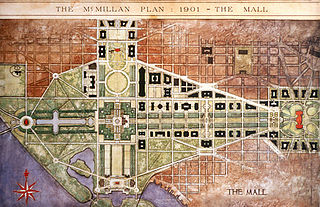
The McMillan Plan is a comprehensive planning document for the development of the monumental core and the park system of Washington, D.C., the capital of the United States. It was written in 1902 by the Senate Park Commission. The commission is popularly known as the McMillan Commission after its chairman, Senator James McMillan of Michigan.
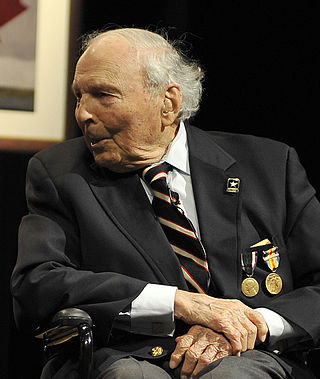
Frank Woodruff Buckles was a United States Army corporal and the last surviving American military veteran of World War I. He enlisted in the U.S. Army in 1917 aged 16 and served with a detachment from Fort Riley, driving ambulances and motorcycles near the front lines in Europe.

The John Paul Jones Memorial, also known as Commodore John Paul Jones, is a monument in West Potomac Park, Washington, D.C. The memorial honors John Paul Jones, the United States' first naval war hero, and received the Congressional Gold Medal after the American Revolutionary War ended. Jones allegedly said "I have not yet begun to fight!" during the Battle of Flamborough Head.
Washington, D.C., is the capital city and federal district of the United States. Below is a list of Washington, D.C.-related articles.

The following outline is provided as an overview of and topical guide to the District of Columbia:

Frederick Hiester Brooke was an American architect from Washington, D.C., who designed houses, schools, churches, and embassies during his 40-year career. A native of Pennsylvania, Brooke studied in the US and France before opening his practice in the nation's capital. He served overseas during World War I and would later design a memorial in West Potomac Park which honors local soldiers. He was an active member in several professional organizations, most notably the American Institute of Architects. Brooke's wife, Henrietta, served as president of the Girl Scouts in the 1930s. Among Brooke's notable works are Dumbarton Oaks, the District of Columbia War Memorial, the Sulgrave Club and the British Ambassador's residence, which he codesigned with Edwin Lutyens.
